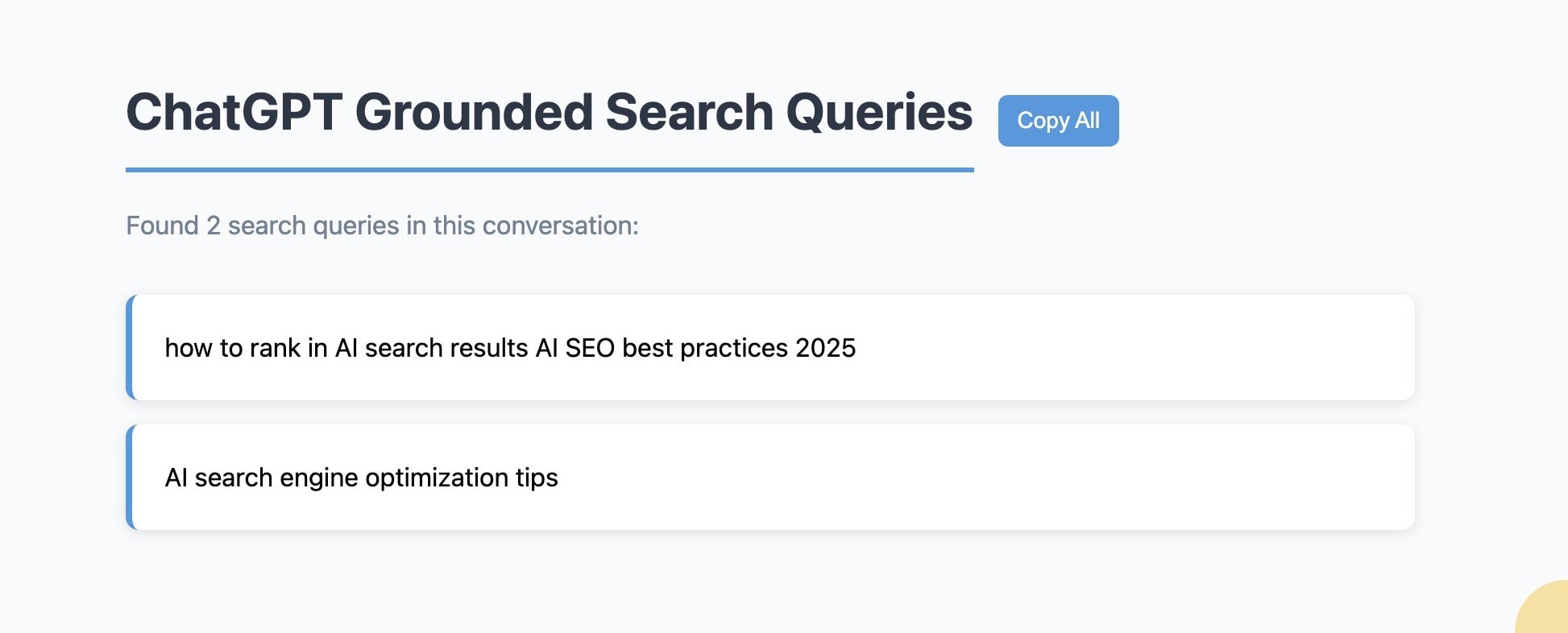
As AI-driven search becomes central to how people discover and trust information, understanding how large language models (LLMs) like ChatGPT think—and more importantly, how they search—is now a true competitive edge.
A new, brilliantly simple tool created by Ziggy Shtrosberg, a search engine optimization professional and Senior Technical SEO Analyst at 26PMX, gives us an unprecedented look into this hidden layer. The ChatGPT Search Query Extractor lets you see exactly what ChatGPT is searching for behind the scenes when answering your prompts.
Imagine you could peek into the mind of Google’s algorithm to see what it prioritizes before it shows you a ranked list. This tool does just that for ChatGPT. It reveals the intermediate search queries the model submits to the internet to build its final response.
Here is a video of the tool at work:
Contents
Why is this so valuable?
Traditionally, SEO practitioners and marketers have relied on tools like Answer the Public, “People Also Ask” data, and keyword clustering platforms to understand what questions audiences are asking. These tools help uncover topical demand and content gaps, but they don’t tell you how AI interprets, reframes, or expands a query before delivering an answer.
By layering ChatGPT’s actual search queries on top of these classic insights, we gain a powerful new vantage point:
- Track evolving prompts: See how AI refines and reframes user queries over time.
- Understand AI sentiment and priorities: Learn what kinds of sources or angles the AI prefers to feature.
- Map your competitive positioning: Analyze which competitors or sources AI is pulling from and how your brand measures up.
- Guide new content creation: Identify opportunities to serve user needs better by providing missing data, sharper insights, or stronger authority signals.
Building a smarter content strategy
Pairing this tool with frameworks like the AI SEO Content Accelerator 14-Step Framework (which focuses on foundation, content architecture, and continuous monitoring) means you can not only dominate traditional search rankings but also shape AI-driven overviews and citations.
With insights into the AI’s search process, you can design content that doesn’t just “rank”—it resonates with the model’s decision-making logic. You can engineer your pages and multimedia assets (videos, podcasts, data visualizations) to:
- Provide novel data that AI wants to surface.
- Show confident, clear structure that simplifies complex topics.
- Offer comparative information to help AI answer nuanced queries with authority.
- Empower human readers to make confident decisions, strengthening trust signals that AI algorithms prioritize.
Tracking and refining over time
The ability to see these internal AI queries opens a new frontier in ongoing optimization. By capturing and analyzing these queries, you can track how your brand’s representation in AI search evolves, adjust your content strategy proactively, and maintain alignment with both human audience needs and AI model expectations.
This isn’t just theoretical. As AI becomes the default front door to the internet—via summaries, overviews, and direct answers—brands that understand and meet these hidden queries will be the ones readers (and algorithms) trust first.
Give it a try
Check out the ChatGPT Search Query Extractor by Ziggy Shtrosberg today and start uncovering how ChatGPT explores the web for your prompts.
- The Micro-Strategies That Make AI SEO Actually Work - December 2, 2025
- Google AI Overviews Clear 60% as New Data Suggests ChatGPT Will Surpass Google Search Traffic by 2027 - November 16, 2025
- AI SEO for B2B Companies: How to Compete in an AI-Driven Search Landscape - November 16, 2025
